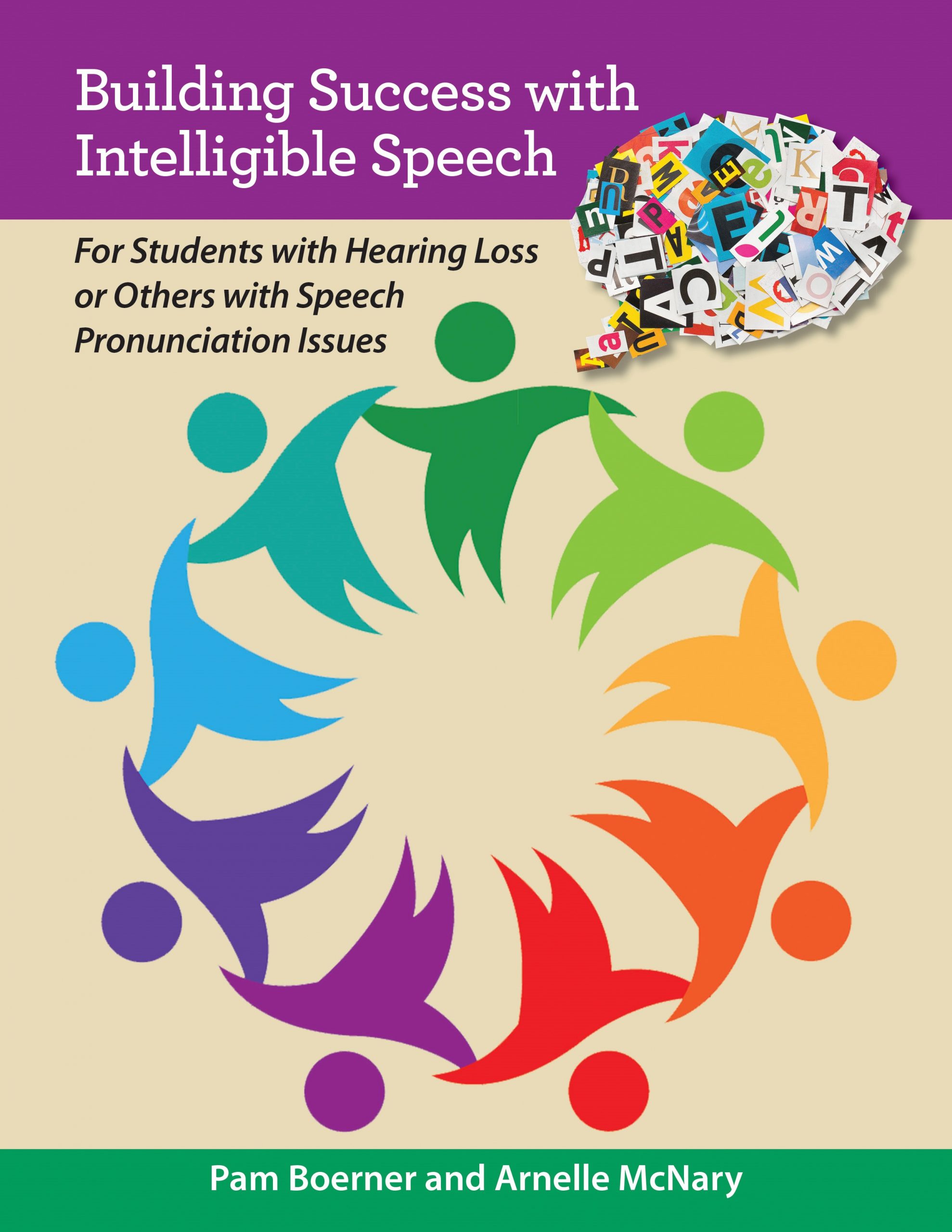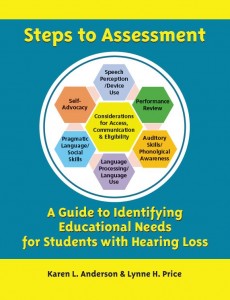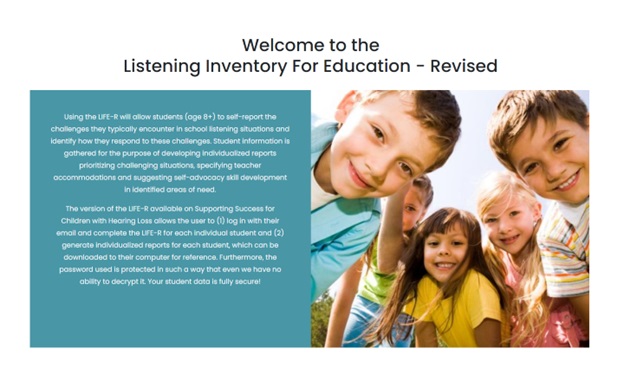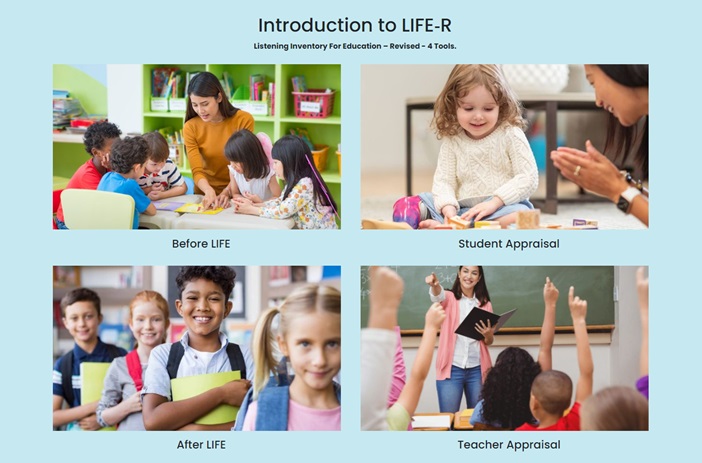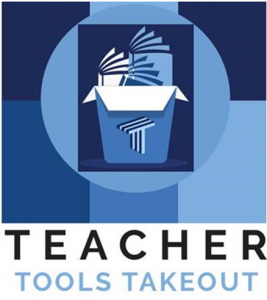Related Products
For Professionals
- Amplification
- Assessment of Student Skills, Challenges, Needs
- Early Childhood: Infants, Toddlers, Preschool
- Hearing Loss – Identification, Impact and Next Steps
- IDEA Law Summary Information
- Language and Speech Development Issues
- Legal Issues in Serving Children with Hearing Loss
- Listening (Auditory Skills) Development
- Planning to Meet Student Needs
- Self-Advocacy Skills for Students with Hearing Loss
- Self-Concept: How the Child with Hearing Loss Sees Himself
- Social Skills
- Speech Perception & Learning
Related Teacher Tools Takeout Items
Listening Inventory For Education – Revised (LIFE-R)
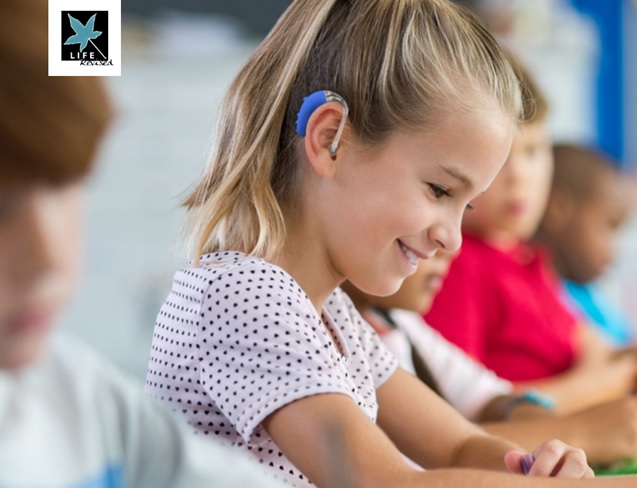
NEW! Streamlined and easier to use
Listening Inventory For Education-Revised (LIFE-R)
This FREE tool is exclusively offered by Supporting Success for Children with Hearing Loss.
What is it?
The Listening Inventory For Education – Revised efficacy tools are multi‐faceted and flexible for use with elementary and secondary school students. The addition of self‐advocacy items is a useful way to obtain baseline information on student performance that will encourage the inclusion of self‐advocacy skills in individualized educational plans. More importantly, identifying student challenges to school listening situations and their responses to these challenges is a critical first step in developing appropriate individualized accommodations and appropriate learning goals that will result in higher levels of Lifelong independence for students.
If you are:
- Struggling to describe to parents and teachers the IMPACT your student’s hearing difference has in the educational setting
- Need an easy way to generate accommodations based on what your students say they find difficult
- Struggling with how to help your student advocate for him/herself in difficult listening situations
Register for free and start using the LIFE-R to help you develop the individualized education plan your student needs TODAY!
| GO TO LIFE-R |
How does it benefit me and my students?
Completing the Before LIFE-R and the Student LIFE-R
- Generates a report that can be used to describe the specific listening challenges experienced by the student in various settings and conditions.
- Generates an Individualized Accommodations Report specific to and based on the student’s answers that describes the IMPACT of the student’s hearing loss in the classroom.
- Generates Recommendations for Self-Advocacy Skill building specific to and based on the student’s answers to the BEFORE-LIFE and Student Appraisal.
Register for free and start using the LIFE-R to help you develop the individualized education plan your student needs TODAY!
| GO TO LIFE-R |
BEFORE LIFE-R
Student Appraisal of Listening Difficulty ‐ Before LIFE‐R Questions for Students: Comprised of six multiple choice questions in which the student describes his classroom listening setting. It is intended that this ‘get‐set’ activity will prepare the student to accurately represent his listening challenges as s/he responds to the Student LIFE‐R listening situations.
STUDENT Appraisal of Listening Difficulty
Student Appraisal of Listening Difficulty (Student LIFE‐R):  The original 10 classroom and 5 additional social listening situations in school have been updated. The electronic version includes a separate page for each listening situation with a suitable photograph and the rating scale. A student proceeds through each question, viewing the photograph, reading, or being read the question, and selecting his/her level of difficulty hearing or understanding. The short and expanded versions of the questions to ask the student are integrated into the Summary of Listening Challenges.
The original 10 classroom and 5 additional social listening situations in school have been updated. The electronic version includes a separate page for each listening situation with a suitable photograph and the rating scale. A student proceeds through each question, viewing the photograph, reading, or being read the question, and selecting his/her level of difficulty hearing or understanding. The short and expanded versions of the questions to ask the student are integrated into the Summary of Listening Challenges.
Student Appraisal of Listening Difficulty – After LIFE Questions for Students
Student Appraisal of Listening Difficulty ‐ After LIFE Questions for Students: After LIFE Questions provide a new avenue of assessment of student function. Six multiple choice questions ask the student to select multiple choice answers that describe how s/he responds when s/he doesn’t hear or understand what was said. The purpose is to briefly assess various self‐advocacy skills that the student identifies as something he uses. The responses can serve as a baseline measure that can justify skill development and shape IEP goal development.
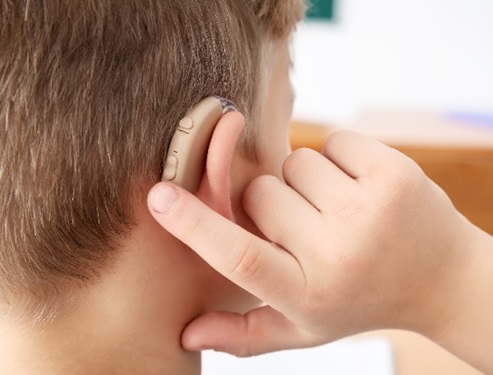
Completion of the Student LIFE‐R requires self‐report by the student. Self‐report measures are most reliable and appropriate for students that are approximately 8 years (3rd grade) or older. The multiple choice questions in the Before LIFE‐R and After LIFE‐R can be administered in a discussion format to younger students depending upon their linguistic development and relative maturity level.
Teacher LIFE-R
The original LIFE Teacher Appraisal could only be used as a post‐test. The content of the Teacher LIFE questions has been changed to allow the Teacher LIFE‐R to be used prior to, and following, a trial with a hearing assistance device (HAT). Questions relate primarily to student attention and class participation; areas of classroom behavior that more sensitively reflect changes to acoustic conditions than specific learning or skills‐based items. The responses to the 15 questions are averaged and scored on a continuum from 15 to 75 possible points with five related ability ranges: 1) No listening challenges or very rare (75), 2) Occasional listening challenges (60), 3) Sometimes experiences listening challenges (45), 4) Often or regularly has listening challenges (30), and 5) Almost always has listening challenges (15).
Teacher Checklist: Self‐Advocacy and Instructional Access: This new checklist provides an assessment tool to aid the student’s team in writing IEP goals related to self‐advocacy, thereby highlighting important skills that should be expected of the student in the classroom. The teacher completes eight questions that describe different self‐advocacy activities. When these responses are considered together with the Student LIFE‐R and After LIFE‐R Questions, the professional with deaf/hard of hearing expertise can identify student self‐advocacy needs, develop appropriate goals and track progress over time.
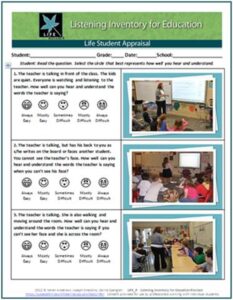
Register for free and start using the LIFE-R to help you develop the individualized education plan your student needs TODAY!
OTHER LIFE-R MATERIALS
Available from Teacher Tools Takeout
Need an option for younger students? Using these scales, younger ones can point to their answers rather than circle.
Check out these options:
LIFE-R Translations:
- LIFE-R in Hebrew
- LIFE-R Student Appraisal Israeli version
- LIFE-R Student Appraisal in Arabic
- LIFE-R Teacher Appraisal in Arabic
- LIFE-R for Elementary in Dutch;
- LIFE-R for Secondary in Dutch
- LIFE-R Teacher Appraisal in Welsh
Go to Teacher Tools Takeout to view other translations.
Interested in translating the LIFE-R to another language? Contact here.
Research Using the LIFE-R
Dutch Validation & Normative Study (2018). Key finding: normal hearing secondary students scored 72% on the LIFE-R Student Appraisal.
IDEA FROM THE FIELD: The e-LIFE-R is a great springboard to get students thinking about their hearing needs and their advocacy needs. Through experiences with students about hearing and advocacy needs, it is so broad that they often have a difficult time getting started and narrowing down what to say. The LIFE-R is the “prep” piece to get them ready for these conversations. We use the information gathered and the dialogues in the following ways, primarily for students transitioning from elementary to secondary school. The students then have the opportunity to highlight the points they would like to express during their school transition meetings and also identify to the school the areas that they need to work on to help ensure access and better listening and learning. Some students choose to verbally state this during their meeting, with the printed LIFE-R as a backup resource for the school to be shared with all teachers; some students create a video of information on how they learn best and what their responsibilities are for learning and listening; and some students create a Google slide/Prezi/PP of themselves. The video has been the most popular as the students can also add a demonstration of their equipment into the video and create a tutorial for staff on how it works. It is also great for teachers to hear this information from the students (as we share the video with all their teachers) and have a opportunity to “meet” them before the start of the school year. The video is a quick reminder as well to the student and teacher of their shared responsibilities for listening and learning. Lauri Doig, Teacher of the Deaf , Ontario Canada

